Special Feature: Products Sally Recommends
My New Mexican Kitchen
In the six months since arriving in Mexico, I’ve been busy visiting the markets and taking cooking classes. Before arriving in Mexico, my Mexican cooking repertoire was limited to tacos and quesadillas—neither of which reflect the complexity and robustness of traditional Mexican cooking.
Now that I’ve gotten my guacamole-legs, so to speak, I’ve started to accumulate some traditional Mexican cookware. Here are descriptions of some of the cookware that I find the most useful.
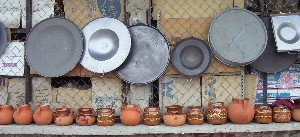 Comal. Traditional comales, which were used by Aztecs to cook over an open fire, are earthenware griddles primarily used for cooking tortillas. In cities and restaurants, metal comales are now more prevalent and are used to cook not only tortillas, but also to dry roast (asar) vegetables and chiles.
Comal. Traditional comales, which were used by Aztecs to cook over an open fire, are earthenware griddles primarily used for cooking tortillas. In cities and restaurants, metal comales are now more prevalent and are used to cook not only tortillas, but also to dry roast (asar) vegetables and chiles.
I own two metal comales and I don’t know how I ever survived cooking without one. I use a comal to roast garlic and it has proven to be the easiest and quickest way I’ve found to do the job. I place unpeeled garlic cloves on a heated comal and turn the cloves every so often. In about 15 minutes, I have roasted garlic cloves. And I didn’t have to heat up an entire oven to do it.
Metal comales come in a variety of sizes and shapes. I love the small round one I have for quick roasting and use a longer oval one for roasting lots of vegetables and chiles for a party.
Before using your comal, whether earthenware or metal, you must season it. You season earthenware comales by spreading a mixture of dry lime with some water thinly on the comal. Heat over a flame—gas, charcoal, or wood—until the lime mixture turns light brown and hardens. Rinse and repeat. Your comal is now sealed and ready for use. You can wash your comal with detergent and warm water. Earthenware comales are prone to breakage. Be sure to have a backup comal!
To season a metal comal, spread a thin film of vegetable oil on the comal surface and heat over a flame—gas, charcoal, or wood—until hot. Let cool and remove excess oil with a paper towel. Repeat and you’re ready to cook. You can wash your metal comal with detergent and warm water, but be sure to dry it thoroughly or it will rust.
You can find metal comales in Mexican groceries or even some supermarkets; it is difficult to find earthenware comales outside of Mexico since they are so fragile. Lacking a comal, you can use a heavy griddle.
Cazuela. The earthenware cooking pot, called a cazuela, is glazed on the inside and left unglazed on the outside. A cazuela, which resembles a bowl with the sides flaring out and a handle on either side of the rim, can be found in just about any Mexican kitchen. It is used on top of the stove, directly on the gas flame. It is not suitable for electric ranges. Cazuelas are made in a variety of sizes and are typically used to cook stews and soups.
Like many pots, cazuelas must be seasoned before their first use. The typical seasoning is to boil water, with an optional garlic clove, in the pot for several minutes. Remove the water, and then repeat once again. Some cooks rub garlic on the unglazed outside of the cazuela to eliminate a too-earthy taste; other cooks prefer the earthy flavor. Many cooks season their cazuelas every time they use them if they do not use them very often.
I use my cazuela often since I began making mole and pipian sauces. At first I couldn’t believe that you could place the cazuela directly on a gas flame, but it works wonderfully.
Because cazuelas are made from clay and fired at a low-heat, the FDA has warned that the lead contained in the glaze can leach. The FDA recommends that you neither cook highly acidic foods in a cazuela nor store foods in one. Mexican potters have become aware of the dangers of lead in their pottery and many are now making lead-free cookware.
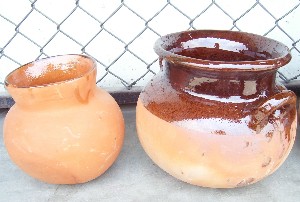 Ollas. Ollas, which are taller and narrower at the top than cazuelas, are used to cook beans. Follow the same directions for seasoning ollas as for seasoning cazuelas. You also need to heed the same warnings about lead leaching.
Ollas. Ollas, which are taller and narrower at the top than cazuelas, are used to cook beans. Follow the same directions for seasoning ollas as for seasoning cazuelas. You also need to heed the same warnings about lead leaching.
There are special ollas, smaller than the bean pots, which you use to make traditional Mexican coffee and chocolate.
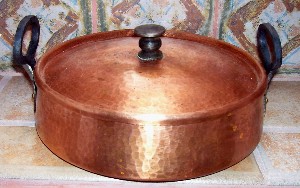 Copper Pots. Long before the Spaniards arrived, the Purepécha Indians in Central Mexico were coppersmiths. The Spaniards taught them new techniques and how to make cazons, a two-handled cooking vessel that is still used today. In the mid-1500s, the Spaniards founded the town of Santa Clara del Cobre as the center of copper making in Mexico.
Copper Pots. Long before the Spaniards arrived, the Purepécha Indians in Central Mexico were coppersmiths. The Spaniards taught them new techniques and how to make cazons, a two-handled cooking vessel that is still used today. In the mid-1500s, the Spaniards founded the town of Santa Clara del Cobre as the center of copper making in Mexico.
The town flourished for hundreds of years, until the early 1900’s when Mexico gained its independence. The coppersmiths of Santa Clara del Cobre continued to make the traditional cazon, but few were buying it. The town declined and was on the verge of extinction.
In the mid-1960’s, the coppersmiths of Santa Clara del Cobre, with the help of American artist, James Metcalfe, obtained the commission to produce the Olympic Torch for the 1968 games in Mexico City.
Today, the coppersmiths of Santa Clara del Cobre produce both unlined and tin-lined copper pieces used for cooking.
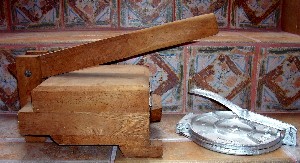 Tortilla Presses. Many Mexicans, especially those in the rural areas (campos), still make tortillas in the traditional manner—by hand. However, most Mexicans nowadays, if they do make tortillas, use a tortilla press.
Tortilla Presses. Many Mexicans, especially those in the rural areas (campos), still make tortillas in the traditional manner—by hand. However, most Mexicans nowadays, if they do make tortillas, use a tortilla press.
There are two kinds of presses—wood and metal. Wooden presses are difficult to find outside of Mexico. If you do find a wooden one, make sure that it is level. The metal presses are available in cast iron or aluminium. You’ll find the heavy cast iron ones are superior in quality and are easier to use. In the United States, you can find metal tortilla presses in Mexican groceries and in Latin American specialty stores. The press should be at least six inches in diameter.
You can buy masa—the corn dough used to make tortillas—at some tortilla factories.Or, you can use masa harina—force-dried fresh masa--which is sold in many supermarkets and Latin American grocery stores.
Although you can buy tortillas, rather cheaply, in most supermarkets, there is really no comparison between a store-bought tortilla and a freshly made tortilla. One of the best things about making your own tortillas is that you can turn those tortillas into antojitos, which translate literally to “little whims,” the simplest one being small quesadillas. See the quesadilla recipe at the end of this article.
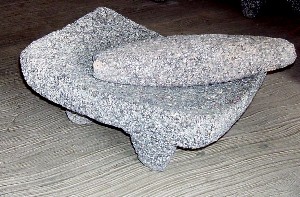 Grinding Utensils. A molcajete (mortar) is not really necessary to make guacamole, but this tool does seem to make the guacamole taste better. A molcajete, with its companion tejolote (pestle), are made of volcanic rock and comes in a dazzling array of sizes, from tiny ones for spices to huge ones that make guacamole for a fiesta. My favorite recipe for guacamole is at the end of this article.
Grinding Utensils. A molcajete (mortar) is not really necessary to make guacamole, but this tool does seem to make the guacamole taste better. A molcajete, with its companion tejolote (pestle), are made of volcanic rock and comes in a dazzling array of sizes, from tiny ones for spices to huge ones that make guacamole for a fiesta. My favorite recipe for guacamole is at the end of this article.
Most Mexican mole and pipian sauces require the grinding of spices and nuts. Traditionally, the molcajete was used to grind spices and tomatoes and the metate, also crafted from volcanic rock, was used to grind nuts and maize (corn) to make masa for tortillas. Today, some purists still use a molcajete to make guacamole, but few modern Mexican kitchens use either a molcajete or metate to grind spices or nuts, choosing instead, to use a blender.
Today, any Mexican kitchen worth its guacamole has a blender, perhaps two. More important than a food processor, a blender blends the chiles, garlic, and liquids to make salsas. However, don’t use a blender to make guacamole—it will turn out, well, too blended. If you don’t have a molcajete, mince the onions, chiles and garlic and then use a fork to smash the avocado.
Almost as important as a blender is a spice/nut grinder. To make any kind of mole or pipian sauce, you need to toast the nuts and then grind them to a paste. The modern way to do this is to use an electric nut grinder. I’ve been using my old standby coffee grinder and it works very well. I’ve seen some super-duper nut grinders in cooking classes that hold much more than my small coffee grinder and I’ve been thinking about upgrading.
Mexican Ceramics. Okay, I know these aren’t really cookware items, but a cook deserves some beauty in her life. Mexicans have long been known for their brightly colored pottery and ceramics. These dishes and serving pieces make the food look great and, let’s face it, presentation counts.
Since moving to Mexico, I’ve assembled a beautiful array of brightly-colored square dishes and serving pieces.
I’m now ready to cook—and serve—great Mexican food.
Guacamole
Since we’ve arrived in Mexico, I’ve been working on my guacamole recipe. I think roasting the vegetables gives this guacamole more depth. If you don’t have a molcajete (or another mortar and pestle), cut the roasted onion, garlic and chile into a small dice before adding the avocado.
3 ripe avocados (preferably Hass)
½ medium onion
1 garlic clove, unpeeled
1 medium tomato
1 serrano chile
2-3 springs cilantro, minced
1-2 limes
salt, to taste
Heat a comal or griddle over medium heat. When hot, place the onion, garlic clove, tomato and chile on the comal. Turn the vegetables so that they brown on all sides, approximately 15 to 20 minutes. Remove from heat and let cool a little. Peel the garlic clove. Coarsely chop the onion, garlic and chile. Coarsely chop the tomato and set aside.
In a medium-sized molcajete (or a ceramic mortar), grind the onion, garlic and chile to a paste (leave some chunks).
A few minutes before you’re ready to serve, peel the avocados and mash them in the onion mixture using a fork or the back of wooden spoon. Squeeze a lime or two into mixture and add some salt, to taste. Mix in the minced cilantro—you can save some as a garnish, if you like—and chopped tomato.
You can serve the guacamole right in the molcajete, with some tortilla chips.
Quesadillas
You can fill quesadillas with whatever you like. In this recipe, I’ve kept it simple and used cheese with a chopped serrano chile to add some bite.
I like to make these bite-sized, so use a small walnut-sized knob of masa. If you’re using ready-made tortillas, you can use a cookie cutter to make small circles. Depending on how small—or large—you make the tortillas, you may get more or less than 12 from this recipe.
1 pound (½ kilo) masa, or use 12 corn tortillas
10 ounces Mexican queso fresco or Monteray Jack, shredded
12 leaves of fresh epazote (optional)
1 serrano chile, dry roasted on a comal and finely chopped
vegetable oil
2 plastic Baggies, or plastic wrap
To Make the Tortillas
Place a plastic baggie on the bottom portion of a metal tortilla press.
Divide the masa into twelve pieces—each about walnut-sized—and roll into a ball. You can add a bit of water if it is too dry. Place the ball on a plastic baggie and place another baggie over it. Press down to form the tortilla. Be sure to keep the remaining masa pieces under a damp towel so they don’t dry out.
To Make the Quesadillas
Lay the tortilla on a flat surface. Add one portion of the cheese and chile to the one-half of the tortilla. Top with an epozote leaf. Fold the unfilled tortilla half over the filled one, forming a half-moon.
In a small skillet, heat 1 inch of vegetable oil until hot. Fry two or three quesadillas at a time in the oil until golden, then flip and fry the second side. Drain on paper towels and keep warm. Serve immediately.
![]()
Arlene Krasner is a former high-tech engineering manager. She is currently living in San Miguel de Allende, Mexico.
Note: This information was accurate when it was published. Please be sure to confirm all rates and details directly with the businesses in question before making your plans.



